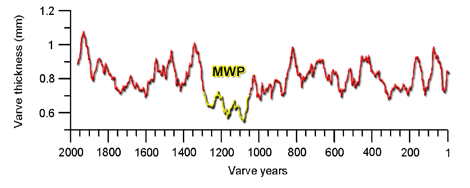Reference
Haltia-Hovi, E., Saarinen, T. and Kukkonen, M. 2007. A 2000-year record of solar forcing on varved lake sediment in eastern Finland. Quaternary Science Reviews 26: 678-689.
Description
The authors extracted two sediment cores from Lake Lehmilampi (63°37'N, 29°06'E) in eastern Finland, after which they identified and counted the approximately 2000 annual varves contained in each core and measured their individual thicknesses and mineral and organic matter contents, which they found to be related to residual δ14C data derived from tree rings, which serve as a proxy for solar activity. Consequently, because they note that (1) "the thinnest varves of the last 2000 years were deposited during [the] solar activity maxima in the Middle Ages," specifically AD 1060-1280, that (2) the low deposition rate of mineral matter in that period "implies mild winters with a short ice cover period during that time with minor snow accumulation interrupted by thawing periods," and that (3) the concurrent "low accumulation of organic matter suggests a long open water season and a high decomposition rate of organic matter," it follows that the solar-induced Medieval Warm Period of AD 1060-1280 in that part of the world was likely the warmest period of the past two millennia.





